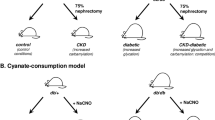Abstract
To elucidate the biochemical basis of impaired skin collagen maturity in pyridoxine-or riboflavin-deficient rats the following two mechanistic possibilities were tested: (i) Reduction in the activity of skin lysyl oxidase (EC 1·4·3·13) which initiates the cross-linking of collagen and (ii) putative rise in homocysteine level leading to neutralization of allysine (α-aminoadipic acid δ-5-semialdehyde)or hydroxyallysine (hydroxy α-aminoadepic acid (δ-semialdehyde) in collagen by the formation of thiazine complexes.
Skin lysyl oxidase activity was not affected in pyridoxine deficiency suggesting that pyridoxal phosphate may not be its cofactor. In riboflavin deficiency, lysyl oxidase activity was not altered in the newly regenerated rat skin but a slight reduction was observed in the skin of 18-day-old rat pups. This could be related to the body weight deficit rather than deficiencyper se. Aldehyde content of purified salt soluble collagen of regenerated skin was significantly reduced in both the deficiencies. A 2 to 4-fold increase in the concentration of skin homocysteine was observed in both the deficiencies. The results suggest that increase in skin homocysteine level may be responsible for the impaired skin collagen maturity in riboflavin or pyridoxine deficiency.
Similar content being viewed by others
References
Bayoumi, R. A. and Rosalki, S. B. (1976)Clin. Chem.,22, 327.
Bird, T. A. and Levene, C. I. (1982)Biochem. Biophys. Res. Commun.,108, 1172.
Bird T. A. and Levene, C. I. (1983)Biochem. J.,210, 633.
Deshraukh, K. and Nimni, M. E. (1969)J. Biol. Chem.,244, 1787.
Kang, A. H. and Trelstad, R. L. (1973)J. Clin. Invest.,52, 2571.
Lakshmi, A. V. and Bamji, M. S. (1979)Biochem. Med.,22, 274.
Lakshmi, A. V-, Diwan, P. V. and Bamji, M. S. (1988)Nutr. Res.,8, 1203.
Lakshmi, R., Lakshmi, A. V. and Bamji, M. S. (1989)Biochem. Med. Metab. Biol.,42, 185.
Levene, C. I., O’shea, M. P. and Carrington, M. J. (1988)Int. J. Biochem.,20, 1451.
Myers, B. A., Dubick, M. A., Reynolds, R. D. and Rucker, R. B. (1985)Biochem. J.,229, 153.
Paz, M. A., Blumenfeld, O. O., Rojkind, M., Henson, E., Furfine, C. and Gallop, P. M. (1965)Arch. Biochem. Biophys.,108, 548.
Piez, K. A., Eigner, E. A. and Lewis, M. S. (1962)Biochemistry,2, 58.
Prasad, R., Lakshmi, A. V. and Bamji, M. S. (1983)Biochem. Med.,30, 331.
Prasad, R., Lakshmi, A. V. and Bamji, M. S. (1986a)Ann. Nutr. Metab.,30, 300.
Prasad, R., Lakshmi, A. V., Bamji, M. S. and Venkatappaiah, V. (1986b)J. Clin. Biochem. Nutr.,1, 59.
Robins’, S. P. and Bailey, A. J. (1975)Biochem. J.,149, 381.
Rowe, D. W., McGoodwin, E. G., Martin, G. R. and Grahn, D. (1977)J. Biol. Chem.,252, 939.
Smolin, L. A., and Benevenga, N. J. (1982)J. Nutr.,112, 264.
Smolin, L. A., Crenshaw, T. D., Kurtycz, D. and Benevenga, N. J. (1963)J. Nutr.,113, 2022.
Trackman, P. C, Zoski, G. C. and Kagan, H. M. (1981)Anal. Biochem.,113, 336.
Van der Meer, R. A. and Duine, J. A. (1986)Biochem. J.,239, 789.
Williamson, P. R., Moog, R. S, Dooley, D. M. and Kagan, H. M. (1986)J. Biol. Chem.,261, 16302.
Author information
Authors and Affiliations
Rights and permissions
About this article
Cite this article
Lakshmi, R., Lakshmi, A.V. & Bamji, M.S. Mechanism of impaired skin collagen maturity in riboflavin or pyridoxine deficiency. J Biosci 15, 289–295 (1990). https://doi.org/10.1007/BF02702670
Received:
Revised:
Issue Date:
DOI: https://doi.org/10.1007/BF02702670




